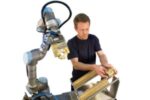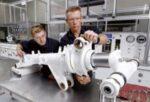Universal Robots marks 25,000 cobot milestone
Vietnam’s Vinacomin Motor Industry Joint Stock Company presented one-of-a-kind Gold Edition robot in celebration of Universal Robots’ milestone Universal Robots (UR), the pioneer and market leader in collaborative robots (cobots), has cemented its market leadership after hitting 25,000 cobot sales. To celebrate this significant milestone, the company awarded ten of its 25,000 global customers a Gold Edition cobot. The lucky winner in Southeast Asia is Vietnam’s Vinacomin Motor Industry Joint Stock Company (VMIC), which was presented with the one-of-a-kind UR10 cobot on 9 October 2018. The special edition cobot has the joints painted in a rich, gold-coloured finish, a refreshing take on UR’s iconic blue and grey cobots. Based in Vietnam’s Quang Ninh province, VMIC is engaged in the manufacture, assembly, maintenance and repair of transportation vehicles. The Company’s leading products are heavy duty trucks used in the delivery of mining products, together with light trucks and other utility vehicles. Other business activities include the production of automotive parts, industrial machinery and equipment trading, the construction of industrial and civil infrastructure, as well as the provision of technical consulting services. “We are thrilled to receive the Gold Edition UR10 cobot which will be deployed to assist in the production of parts for transport vehicles, working alongside our employees,” said Pham Xuan Phi, VMIC Chairman and CEO. “The need to improve productivity and reduce operational cost led us to opt for cobots as the ideal solution. Since deploying our first cobot in July this year, we have already seen productivity surge 30 per cent and improvements in product quality and takt time stability,” he added. “We couldn’t have reached this historic 25,000-cobot landmark without excellent customers like VMIC,” said Sakari Kuikka, APAC Regional Director of UR. “With this, we celebrate not just the success of UR in empowering customers, but also […]










